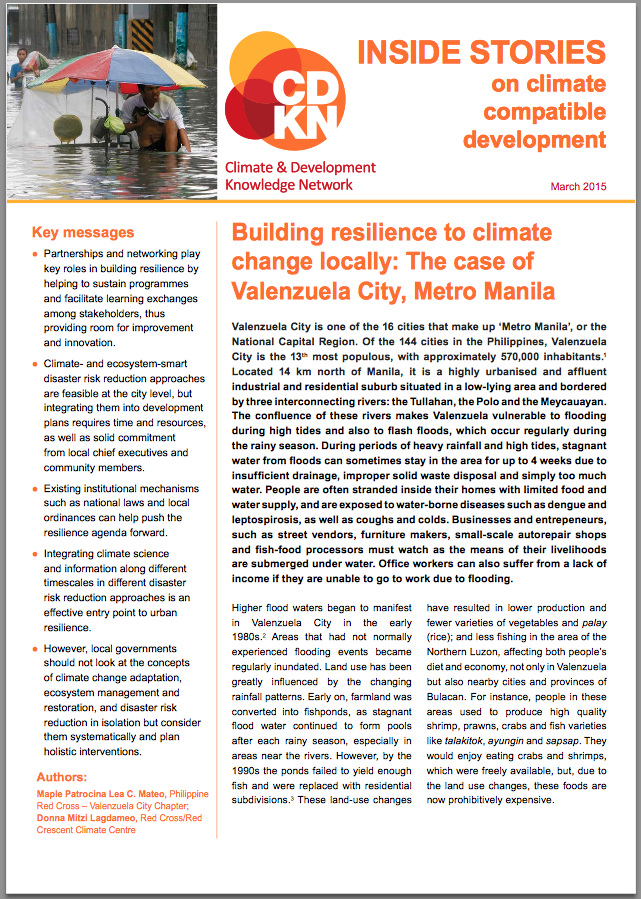Case-study /
INSIDE STORY: Building resilience to climate change locally: The case of Valenzuela City, Metro Manila


Valenzuela City is one of the 16 cities that make up ‘Metro Manila’, or the National Capital Region. Of the 144 cities in the Philippines, Valenzuela City is the 13th most populous, with approximately 570,000 inhabitants. Located 14 km north of Manila, it is a highly urbanised and affluent industrial and residential suburb situated in a low-lying area and bordered by three interconnecting rivers: the Tullahan, the Polo and the Meycauayan. The confluence of these rivers makes Valenzuela vulnerable to flooding during high tides and also to flash floods, which occur regularly during the rainy season. During periods of heavy rainfall and high tides, stagnant water from floods can sometimes stay in the area for up to 4 weeks due to insufficient drainage, improper solid waste disposal and simply too much water. People are often stranded inside their homes with limited food and water supply, and are exposed to water-borne diseases such as dengue and leptospirosis, as well as coughs and colds. Businesses and entrepeneurs, such as street vendors, furniture makers, small-scale autorepair shops and fish-food processors must watch as the means of their livelihoods are submerged under water. Office and other urban-based employees can also suffer from a lack of income if they are unable to go to work due to flooding.
Key messages
-
Partnerships and networking play key roles in building resilience by helping to sustain programmes and facilitate learning exchanges among stakeholders, thus providing room for improvement and innovation.
-
Climate- and ecosystem-smart disaster risk reduction approaches are feasible at the city level, but integrating them into development plans requires time and resources, as well as solidcommitment from local chief executives and community members.
-
Existing institutional mechanisms such as national laws and local ordinances can help push the resilience agenda forward.
-
Integrating climatescience and information along different timescales in different disaster risk reduction approaches is an effective entry point to urban resilience.
-
However, local governments should not look at the concepts of climate change adaptation, ecosystem management and restoration, and disaster risk reduction in isolation but consider them systematically and plan holistic interventions.
Implications for decision-makers and practitioners
This case study shows that building resilient urban communities through an integrated approach of disaster risk reduction, climate change adaptation and ecosystem management and restoration is possible. However, it is not easy and it does not happen overnight. A lot of investment in people, time and other resources is needed to sensitise people and change behaviour, help LGUs provide institutional support, and motivatecommunities to adopt life-changing skills in order to anticipate, adapt and respond to changing risk patterns. When successful, these communities can address the root causes of risk and transform their responses, so avoiding potential disasters.
National and local policies and institutional mechanisms are key for effective disaster risk reduction. These provide the backbone for initiating changes on the ground. Particularly with a decentralised local governance structure – such as in the Philippines, where LGUs are empowered to move things forward – the presence of a national law provides guidance for the country to move forward as a whole. For example, local resolutions and ordinances enhance existing laws such as the Ecological Solid Waste Management Act of 2000 (RA 9003): from this foundation, LGUs may form barangay solid waste management councils and resolve – down to the household level – how solid wastes should be segregated and collected.
Finally, this case study shows howdisaster risk reduction, climate change adaptation and ecosystem management and restoration actually interact on the ground. Rather than treating them in their own silos, they need to be addressed in a more holistic way. The integrated PfR approach is an effective way to build climate- and ecosystem-smart, resilient communities.
Authors
Maple Patrocina Lea C. Mateo,PhilippineRed Cross – Valenzuela City Chapter;
Donna Mitzi Lagdameo,Red Cross/Red Crescent Climate Centre
